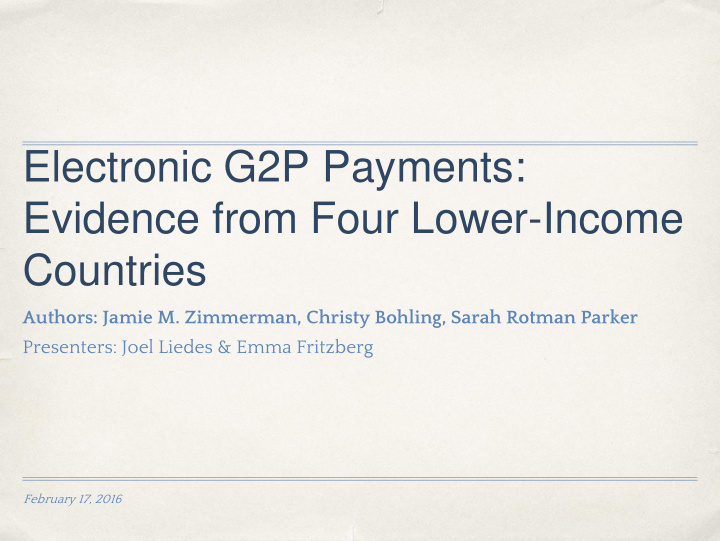



Electronic G2P Payments: Evidence from Four Lower-Income Countries Authors: Jamie M. Zimmerman, Christy Bohling, Sarah Rotman Parker Presenters: Joel Liedes & Emma Fritzberg February 17, 2016
Background ● 2012 CGAP Focus Note “Social Cash Transfers & Financial Inclusion: Evidence from Four Countries” (Bold, Porteous, & Rotman) ● analyzed government-led cash transfer programs in Brazil, Mexico, Colombia, & South Africa (middle-income countries) ● 3 major considerations: affordability for the government, profitability for payment service providers (PSPs), likelihood of recipients using the services for personal use beyond receiving transfer ● findings: cash transfer programs were affordable for the government and profitable for PSPs if the government paid adequate fees, but recipients were unlikely to adopt the services for additional personal use ● The paper represents the authors findings regarding G2P payments in 4 lower-income countries: Haiti, Kenya, the Philippines, and Uganda.
● Ti Manman Cheri (TMC), Haiti: government-led, reaching 75,000 mothers of schoolchildren, transfer of money conditional on children’s enrollment in school, uses MNO Digicel TchoTcho Mobile ● Cash For Assets (CFA), Kenya: joint effort of World Food Programme and Kenyan government, targets food-insecure households, recipients work on community assets projects, worked with Equity Bank from 2009, now Cooperative Bank ● Pantawid Pamilyang Pilipino Program (4 Ps), the Philippines: government-run, donor-supported, targets poor households with pregnant mothers and/or children between ages 0 and 14, primary payment service provider is Land Bank of the Philippines ● Social Assistance Grants for Empowerment (SAGE), Uganda: targets senior citizens and vulnerable families, unconditional, payment service provider is MTN, core objectives are transparency, scalability, financial inclusion
Comparing Payment Approaches
Comparing Payment Costs
6 Findings 1. Country-Level Readiness, Especially for Mobile Solutions, Was Overestimated. 2. The Technical Capacities Required to Shift from Cash to E-Payments Were Often Underestimated. 3. Internal and External Pressure on Design and Implementation Was Inevitable. 4. Agents Affected the Experience of Recipients and While the Agents’ Control of PINs Was Expeditious, It Also Carried Risks. 5. Recipient Capability Was Greatly Affected by Program and Payment Method Training as Well as the Availability and Timeliness of Payments. 6. Appropriate Recipient Recourse Mechanisms Built Confidence and Trust.
5 Lessons 1. Ensure Reliable Payments First. 2. Create Sufficient Communication Channels with Recipients. 3. Ask “What If?” 4. Ensure a Value Proposition for All Stakeholders. 5. Be Willing to Invest.
Discussion Questions ● Are there any other take-aways you can draw from the findings? ● One of the lessons is “Ask ‘what if?’” What are the authors suggesting by this? ● If you were an investor, what would you look for in a program? ● Why are bi-monthly payments the standard? ● What are the negative consequences of infrequent payments? What causes them? What are the possible solutions? ● Once a system exists, how can it be tested? ● How can the success of a program be measured? ● What contributes to a program’s success? ● What are the components of a successful social program? Where do cash transfer mechanisms factor in? ● What are the similarities between G2P payments and P2P payments? What are the differences?
Recommend
More recommend